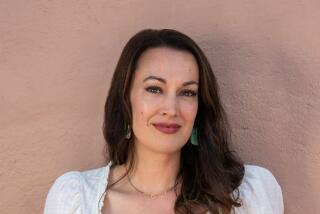Book Review : The Ways of Women Through the Ages
- Share via
The Seven Ages by Eva Figes (Pantheon Books: $14.95)
Though her publishers call “The Seven Ages” fiction, Figes’ work defies convenient categorization, partaking of several genres but belonging to none. Myth, folklore, legend, romance, history and even polemic blend, overlap and separate in this book; the loose ends held together by the strong and distinctly contemporary voice of the narrator, an English nurse-midwife now retired and living in a country cottage. Readers acquainted with the author’s earlier books, “Waking,” which chronicled the writer’s emotions and sensations as she surfaces from sleep, will be prepared for the sophisticated changes she can ring upon the idea of time; those who remember “Light,” a re-creation of a day in the painter Monet’s old age at Giverny, will feel at home with her lyrical glides between fact and fancy. Her nonfiction work, “Patriarchal Attitudes,” is a scholarly and intensely feminist document, one of the most influential to emerge from the modern English movement.
Passionate Lyricism
“The Seven Ages” explores some of this territory with passionate lyricism, delving a thousand years back to find an archetypal woman, moving forward by increments of centuries to place others into medieval, Elizabethan, Georgian, Victorian and finally modern contexts. Each of these fictive women speaks in the rhythms and images of her respective ear, conjured up by the narrator’s imagination, brought to hallucinatory heights by Figes’ identification with the land and the people who inhabited her ancient part of England. While all this may sound intimidatingly artificial and didactic, the ultimate effect is compelling.
Even though “The Seven Ages” is obsessively concerned with childbirth, the deftly managed historical background expands the specific subject and places it into perspective. Still, there’s no getting away from the theme, which is that for most of recorded time, every woman risked death in childbirth every year of her adult life. As Samuel Johnson said, the prospect of hanging concentrates the mind most wonderfully. Only a few men ever faced death by the noose, but all women were vulnerable to pregnancy and its hazards. Can we fault them for dwelling upon its perils?
If Figes’ narrator isn’t the actual lineal descendant of the midwives she imagines, she’s obviously their spiritual heiress; a brisk, efficient reincarnation of generations of herbalists and healers, caught at a moment in time when interest in “natural” birth is particularly high. She has two daughters who represent the conflict between obstetrics as science and as art. Kate is carrying on the family tradition totally committed to the new technology; Sally is the romantic, always at odds with her pragmatic sister.
Unlike Figes’ historical characters, who are fully realized and marvelously alive, these two young women seem but shadowy collections of contrasting attitudes. Their mother mediates between them, allowing first one, then the other to speak her piece. Though we know the narrator is on the side of the angels, we’re not always sure whether the angels are the wise women who relied on instincts and folklore or if they might possibly be the scientists whose findings have revolutionized the management of human reproduction.
Fascinating Accounts
While the accounts of births assisted by herbs and charms can be fascinating, the stories told to women in labor to distract them from their agony are splendidly inventive, lending the book charm and distinction. Not all the eventualities were happy. Figes’ archetypes were left weakened, exhausted, and sometimes mad; their children often born with disabilities that have since become preventable. Though primitive methods of contraception, (mostly potions secretely placed in the husband’s food and drink) were seldom efficacious, they’ll seem wonderfully novel to contemporary readers, providing the few genuinely diverting moments in an artful but otherwise grim chronicle.
The only truly effective method of birth control until this century was war, particularly the Crusades, which removed men from England for years at a time, offering women a rare opportunity to demonstrate abilities other than breeding. During these heaven-sent respites, they managed the farms, kept commerce alive, educated themselves and their children and even found time for the arts. Implicit in the text is the clear message that war is no longer a sensible method of family planning.
Though neither bitter nor misanthropic, the cold fact emerging from “The Seven Ages” is undeniable. Until women were offered a way to space their children by a mechanical or chemical device they could employ themselves, their very lives were constantly in jeopardy. Until that moment--a small fraction of the time covered in this book, the idea of free will applied only to half of humanity. For all its poetry, erudition and lore, its varied style and arresting originality, “The Seven Ages” is inevitably redundant, like the women’s lives it celebrates. That shouldn’t stop you from reading it. Redundancy is the point.
More to Read
Sign up for our Book Club newsletter
Get the latest news, events and more from the Los Angeles Times Book Club, and help us get L.A. reading and talking.
You may occasionally receive promotional content from the Los Angeles Times.










